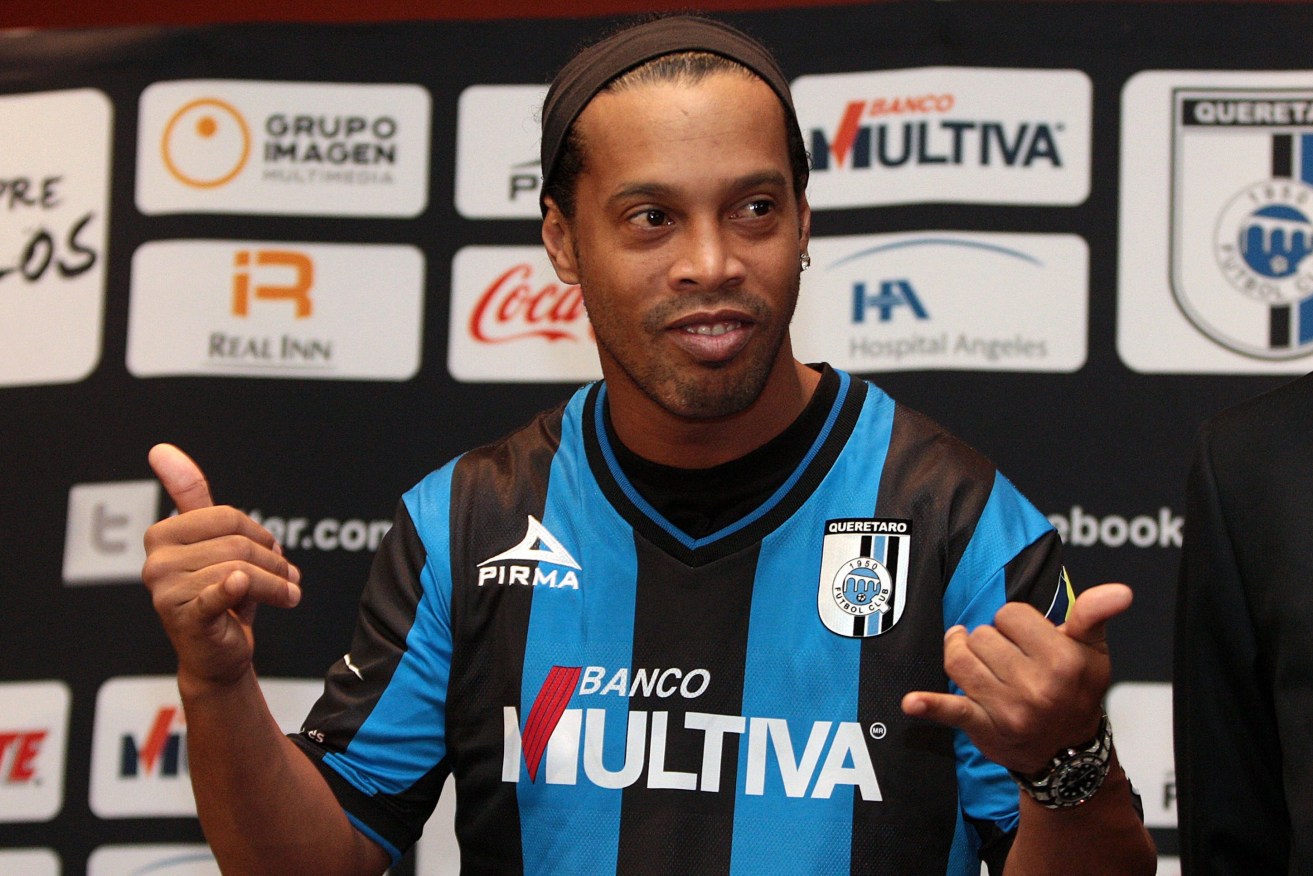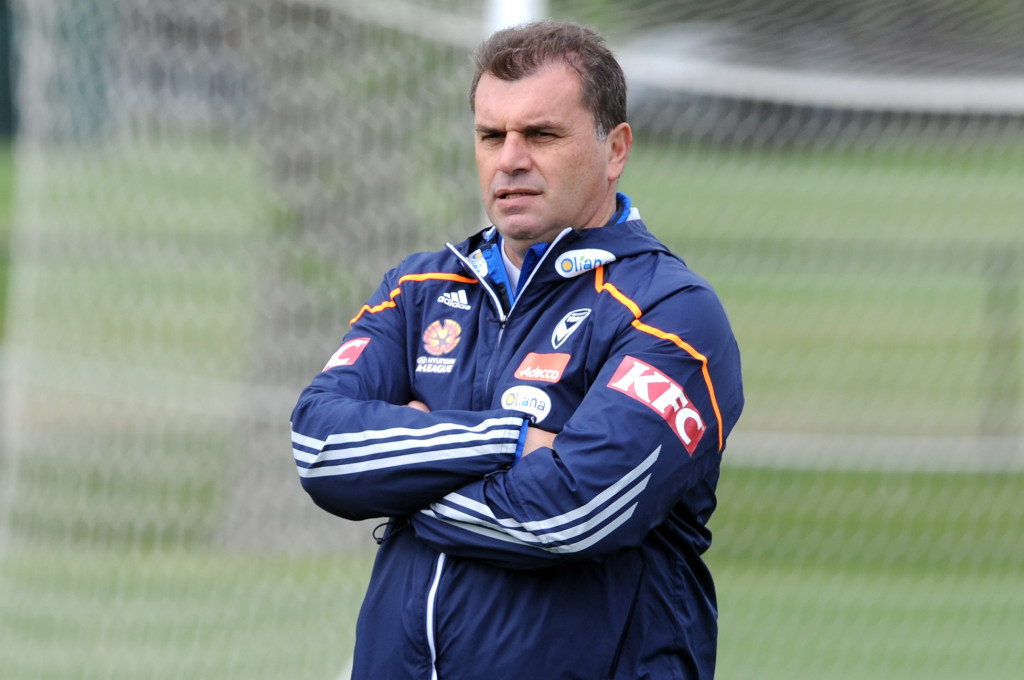Be my guest? No thanks.
Injecting faded international stars into the A-League would be a backward step, argues Paul Marcuccitti.

Brazilian soccer player Ronaldo de Asis Moreira - aka Ronaldinho - on joining Mexico's Queretaro in 2014, one of a raft of short-lived stints since his heyday. Photo: Alex Cruz / EPA
Two weeks ago, Socceroos coach Ange Postecoglou made a series of outrageous statements which, surprisingly, were quickly forgotten.
Where do we start? Perhaps the way he talked up our domestic competition: “Some of the best games I’ll see on a weekly basis are in the A-League and I watch games from all over the world.”
And then the ridiculous notion that we should worry more about what happens on the field instead of what happens off it: “It’s easier to read a balance sheet or … a web poll or see what the crowd is and talk about that for a week than it is to read a football game, but that’s what we should be talking about. Ultimately, that’s what supporters want to talk about.”
Do you like that last bit? That he knows what supporters want? The temerity…
The national team’s boss didn’t finish there: “I think we’re embarking on a generation of the best coaches we’ve ever had … If you look at the guys like Popa (Tony Popovic), Kevin Muscat, John Aloisi, even some of the guys working alongside them … I’ve got Ante Milicic who is going to be an outstanding coach and Ross Aloisi, Jean Paul de Marigny, Scotty Miller…”
It’s easy to see why Postecoglou’s comments were largely ignored. As a domestic coach he won two National Soccer League championships and two A-League championships. And last January he led the Socceroos to Asian Cup glory. Clearly the bloke is clueless.
He also doesn’t seem to understand that people in our game won’t take you seriously unless you paint a bleak picture of Football Federation Australia, the A-League, the Socceroos and, frankly, life in general.
Regular readers might be thinking that all this sounds a bit odd coming from me given that, in less than a year, I’ve managed to criticise FFA’s communications, its handling of the players’ collective bargaining agreement, the way it dealt with the leaked list of banned fans, its attitude to Wellington Phoenix and scheduling of A-League matches, among other things.
Nevertheless, I don’t imagine the game is in crisis. If I were one of the professional detractors, that’s the conclusion I’d draw from every conversation about crowd figures, television ratings and clubs’ balance sheets.
All of these things have worsened (slightly) in the last two or three years. But why do few people point out that they all look amazing when you compare them to, say, 2002?
Now changes and improvements to the way things are done in Australian soccer are definitely needed, however, the result of exaggerating the sport’s problems is that bad ideas are advanced as potential solutions.
One such bad idea has been that we take another look at marquee players given that A-League clubs continue to move away from big names that help increase attendances and revenue from merchandise to chaps that help win games.
Yes, it’s quite outrageous that in a professional competition, clubs are making success on the field a higher priority than selling more replica shirts.
I’ve nothing to add to what I wrote about marquee players in August but since then the Coalition of People Determined to Inflict Silly Ideas on the A-League has found a new cause: use those almost forgotten rules that allow clubs to sign guest players to lure overseas stars.
A guest player must satisfy FFA’s marketability criteria before a club can sign him. But if one does, his payments don’t need to fall within the salary cap. A guest’s nationality doesn’t matter either, so teams that have used their limit of foreigners can sign one.
Since its inception, the A-League has had only five guest players. One of them, Brazilian World Cup winner Romario, famously came to Adelaide United for a four-game stint in 2006 to the annoyance of then coach John Kosmina (this episode is wonderfully described in Loukas Founten’s book about the club’s history: A Decade United).
The name we hear most in discussions about potential guest players in the A-League is that of a former international teammate of Romario’s: Ronaldinho.
A decade ago, Ronaldinho was soccer’s brightest star. He won the World Cup with Brazil in 2002 and the UEFA Champions League with Barcelona in 2006. In 2004 and 2005, he was FIFA World Player of the Year.
But by the time he left Barcelona in 2008 to join Milan, his decline had already begun.
We get greater legitimacy by bringing players that lift the standard
In Italy he made more headlines with his party boy antics than he did with amazing deeds on the pitch. He earned criticism from Carlo Ancelotti and Max Allegri, coaches who are still at the top of the game.
For the 2010 World Cup, when he was still just 30 years old, Ronaldinho wasn’t selected in Brazil’s squad. That would have been unthinkable four years earlier.
After leaving Milan the following year, there was little demand for him around Europe. Ronaldinho has mostly played in Brazil since then with mixed success. His most recent contract with Rio club Fluminense was terminated “by mutual consent” after a handful of games.
What’s the chance of a 35-year-old player, who wasn’t motivated enough to produce his best regularly in one of Europe’s top leagues (when he should have been at his peak), having the drive to make a massive impact on the pitch in the A-League?
And even if he does, what happens when his short guest stint with one of our clubs ends? Exactly what has happened before when other big names have left: the people that turned up just to see them turn away again and then we’ll be looking for another overseas star and then another…
In the A-League’s earlier years, bringing these players here – even as guests – made more sense because the competition needed the exposure.
But now we get greater legitimacy by bringing players that lift the standard. Those who are pining for a Ronaldinho type to arrive were probably horrified when Sydney FC used a marquee spot to sign Marc Janko in 2014.
Janko wasn’t a big name but he scored so frequently that he kept his place in the Austrian national team during its outstanding qualification campaign for this year’s European Championship. He’s now playing in Switzerland – which has a decent league – and he’s still scoring plenty of goals.
Janko didn’t get the romantics’ pulses racing but his time in Australia should be a sign, to people here and overseas, that ours is a serious, professional league.
An unmotivated Ronaldinho, or someone of his ilk, coming here for commercial reasons would be a sign that it’s not.
Our league still experiences plenty of growing pains but it is maturing. So let’s try to be adult about it.
The only thing that remains is for me to apologise to Ange for writing about an off field matter. I promise to get back to what’s happening on the pitch next week.
Paul Marcuccitti is InDaily’s soccer columnist. He is a co-presenter of 5RTI’s Soccer on 531 program which can be heard from 11am on Saturdays.
Manton St Tales is published on Mondays during the A-League season.





